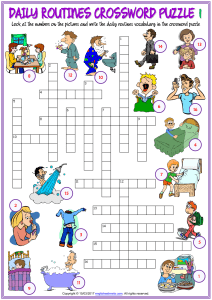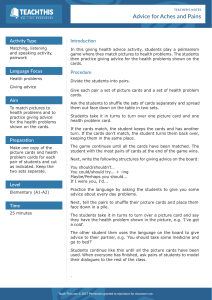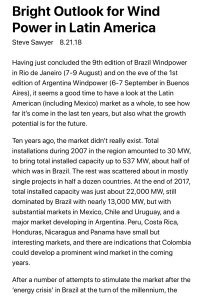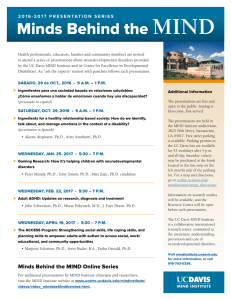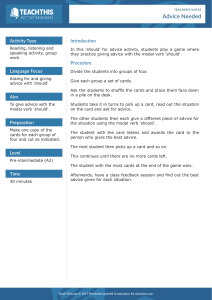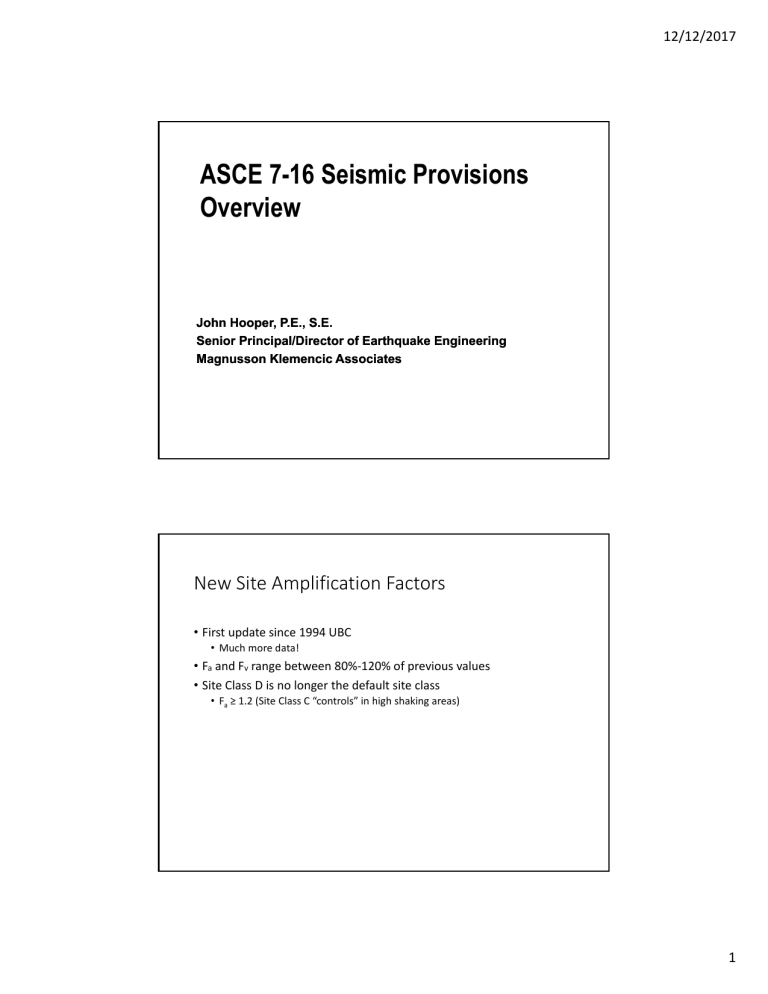
12/12/2017 ASCE 7-16 Seismic Provisions Overview John Hooper, P.E., S.E. Senior Principal/Director of Earthquake Engineering Magnusson Klemencic Associates New Site Amplification Factors • First update since 1994 UBC • Much more data! • Fa and Fv range between 80%‐120% of previous values • Site Class D is no longer the default site class • Fa ≥ 1.2 (Site Class C “controls” in high shaking areas) 1 12/12/2017 2 12/12/2017 3 12/12/2017 4 12/12/2017 5 12/12/2017 Background for Section 11.4.7 Requirement • Use of only two response periods (0.2s and 1.0s) to define ELF (and MRSA) design forces is not sufficient, in general, to accurately represent response spectral acceleration for all design periods • Reasonably Accurate (or Conservative) – When peak MCER response spectral acceleration occurs at or near 0.2s and peak MCER response spectral velocity occurs at or near 1.0s for the site of interest • Potentially Non‐conservative – When peak MCER response spectral velocity occurs at periods greater than 1.0s for the site of interest (e.g., softer soil sites whose seismic hazard is dominated by large magnitude events) 6 12/12/2017 Example ELF “Design Spectrum” based on ASCE 7‐16 (Revised) Site Factors M8.0 earthquake ground motions at RX = 8.5 km, Site Class D/E New Site‐Specific Ground Motion Requirements • Now required for the following site conditions: • Structures on Site Class E sites with Ss ≥ 1.0 • Structures on Site Class D & E sites with S1 ≥ 0.2 • However, exceptions to requiring site‐specific spectra provided if higher Values of Fa or Cs are used 7 12/12/2017 New Site‐Specific Ground Motion Requirements • Exceptions: • Structures on Site Class E sites with Ss ≥ 1.0, provided Fa taken as from Site Class C • Structures on Site Class D & E sites with S1 ≥ 0.2, provided Cs is • determined by Eq. 12.8‐2 for T ≤ 1.5Ts and • taken as 1.5 times value computed by Eq. 12.8‐3 for TL ≥ T > 1.5Ts or Eq. 12.8‐4 for T > TL • Structures on Site Class E with S1 ≥ 0.2, provided T ≤ Ts and ELF is used for the analysis New Vertical Ground Motions • Section 11.9 provides OPTIONAL vertical ground motions in lieu of Section 12.4.2.2 (Ev) for SDC C through F • Initially developed for the 2009 NEHRP Provisions • Keyed to SMS (MCER‐level ground motions) • Design spectrum taken as 2/3 MCER spectrum 8 12/12/2017 New Vertical Ground Motions Chapter 12 Changes 9 12/12/2017 Seismic Load Combinations • Expanded seismic load combinations in Sections 12.4.2.3 and 12.4.3.2 moved to Chapter 2 • Seismic load effects definitions remain in Section 12.4 (E, Eh, Ev, Em, Emh, and Ω0) Seismic Load Combinations • Introduces a new term, Ecl: • The capacity‐limited horizontal seismic load effect, equal to the maximum force that can develop in the element as determined by rational, plastic mechanism Analysis • Emh = Ω0QE need not be taken as larger than Ecl 10 12/12/2017 Updated Requirements for Determination of Cs and Ev for short, regular structures • Section 12.8.1.3 allows SDS = 1.0 but not less than 70% of SDS defined in Section 11.4.4 • • • • • No irregularities Does not exceed five stories T < 0.5sec Meets the requirements for ρ = 1.0 Risk Category I and II Accidental Torsion Change • Section 12.8.4.2. requires accidental torsional moments (Mta) be applied for determination of horizontal irregularities • Mta need NOT be included when determining the seismic forces E for: • Design of the structure • Determination of design story drift • Except for two important cases… 11 12/12/2017 Accidental Torsion Change • These two cases are: 1. 2. Structures assigned to Seismic Design Category B with Type 1b horizontal irregularity Structures assigned to Seismic Design Category C, D, E, and F with Type 1a and Type 1b horizontal structural irregularity New Diaphragm Requirements • Section 12.10.3 required for precast concrete diaphragms; alternative for others • Complete new formulation • Includes potential reduction for diaphragm ductility • Based on analytical and physical research 12 12/12/2017 New Diaphragm Requirements • Change also requires the use of Ω0 for transfer diaphragms (Horizontal Irregularity Type 4—Out‐of‐Plane Offset) Increased by Ω0 Modifications to Modal Response Spectrum Analysis Method • Modified to require 100% of the mass • Introduces rigid body mode concept for T<0.05s • Exception allows 90% of mass as currently done • 15% scaling reduction relative to ELF results is eliminated; must scale to 100% of ELF results 13 12/12/2017 Linear Response History Analysis • Added to Section 12.9 • Advantage of LRHA vs. MRSA • The algebraic signs of all forces and deformations are retained in LRHA; The signs are lost in the modal combinations used in MRSA • Concurrency of actions (axial force and bending moment) are retained in LRHA. Recovery of concurrent actions is not possible in MRSA. LRHA Modeling Requirements The structure must be modeled in three dimensions This is also required in MRSA Where required, accidental torsion must be represented by use of mass offsets This is necessary to retain algebraic signs and concurrency of force. 14 12/12/2017 LRHA Modeling Requirements P‐Delta effects must be included in the analytical model This allows of the inclusion of P‐Theta Effects (amplification of global torsional response) Not less than three sets of Spectrum Matched ground motion must be used. The ground motions are tightly matched to the same spectrum used in MRSA LRHA Ground Motions • Spectrally Matching Ground Motion Records TLower TUpper +/‐ 10% Match Original Unmatched Matched 15 12/12/2017 LRHA Scaling Two analyses (X and Y) are run independently for each ground motion set and scaled to 100% of ELF Base Shear E1_X E1_Y Basic Analyses Used to Determine Scale Factors ηX and ηY LRHA Values used for Design Forces and displacements (story drifts) used for design are based on envelope quantities from all analyses. Envelope values need to be used where interaction of forces is important (e.g., columns and walls) 16 12/12/2017 Strength Design Alternative for Foundations • New Section 12.13.5 Strength Design for Nominal Foundation Geotechnical Capacity • Used when Strength Load Combinations are applied in design • Foundation Capacity, Qus, determined by geotechnical engineer Strength Design Alternative for Foundations 17 12/12/2017 New Structural Requirements for Sites Susceptible to Liquefaction • Current Section 11.8.2 requires geotechnical investigation, including liquefaction and lateral spreading • New Section 12.13.9 provides design requirements • 12.13.9.2 Shallow Foundation Design • 12.13.9.3 Deep Foundation Design Section 12.13.9.2 Shallow Foundations • Buildings permitted to be supported on shallow foundations provided: 18 12/12/2017 Section 12.13.9.2 Shallow Foundations • Shallow foundations meeting differential settlement criteria need only need to follow deem‐to‐comply detailing • Individual footing ties: Ftie = 0.5μPu • Footings integral with minimum 5” slab‐on‐ground with ρ > 0.0025 • Mat foundations need to be designed to accommodate expected vertical differential settlements Section 12.13.9.3 Deep Foundations • Design requirements to account for • • • • Downdrag demands Reduced lateral resistance Concrete pile detailing (ACI reference) Lateral spreading affect on piles deformations and demands • Foundation ties 19 12/12/2017 New Seismic Design Maps: • Based on USGS’s 2014 National Seismic Hazard Maps • New/updated fault characterizations • New Ground Motion Prediction Equations • Changes also resulting from fragility curve β modification (changed from 0.8 to 0.6) Changes in MCER and MCEG Values 20 12/12/2017 Chapter 13 Changes: Nonstructural Components Some Highlights Distribution systems • New definition: DISTRIBUTION SYSTEM: An interconnected system of piping, tubing, conduit, raceway, or duct. Distribution systems include in‐line components such as valves, in‐line suspended pumps, and mixing boxes. • Complete overhaul of provisions addressing these systems. – New provision 7. under 13.1.4 Exemptions – In‐line components such as valves, in‐line suspended pumps, and mixing boxes that require independent support are discrete components that must be braced considering the tributary contribution of the attached distribution system. 21 12/12/2017 Distribution systems • Revision of the 20 lb/400 lb exemptions for mechanical and electrical (M&E) components: • In SDC C, M&E are exempted if either Ip = 1 and the component is positively attached* to the structure, OR if the component weighs less than 20 lb or, if a distribution system, weighs less than 5 lb/ft. *Positive attachment: Understood to not be friction‐ or adhesion‐based. Typically bolts, screws, anchors. Distribution systems • In SDC D, E and F, discrete M&E components are exempted if they are positively attached AND: • the component is 400 lb or less, the center of mass is 4 ft or less above the adjacent floor level, flexible connections are provided, and Ip = 1; or • the component is 20 lb or less; or • the distribution system is 5 lb/ft or less 22 12/12/2017 13.3.1 Overstrength, Vertical Force, Vertically Cantilevered Systems… ASCE 7‐10 Incorrectly interpreted as applying only to vertically cantilevered systems… 13.3.1 Overstrength, Vertical Force, Vertically Cantilevered Systems… ASCE 7‐16 The overstrength factor, Ω0, in Table 13-5.1 and Table 13-6.1, is applicable only to anchorage of components to concrete and masonry where required by Section 13.4.2 or the standards referenced therein and shall be applied in accordance with Section 12.4.3. The redundancy factor, ρ, is permitted to be taken equal to 1 and the overstrength factors in Table 12.2-1 need not apply. The force (Fp) shall be applied independently in at least two orthogonal horizontal directions in combination with service or operating loads associated with the component, as appropriate. For vertically cantilevered systems, however, the force Fp, shall be assumed to act in any horizontal direction. 13.3.1.2 Vertical Force. In addition, tThe component shall be designed for a concurrent vertical force ±0.2SDSWp. The redundancy factor, ρ, is permitted to be taken equal to 1 and the overstrength factor, Ω0, does not apply. 23 12/12/2017 13.3.1 Horizontal Spectra • More options for using analysis in lieu of Fp equation(s) • Linear dynamic modal analysis per 12.9 • Nonlinear response history • Floor response spectra using current equation or new alternate procedure (i.e., Tri‐Services Manual, ref. Kehoe and Hachem, “Procedures for Estimating Floor Accelerations,” ATC 29‐2, 2003) 13.5.3 Exterior Wall Elements • Revision of requirements for connector rods for exterior panels based on testing at UCSD • Rods must be low carbon or stainless steel and as fabricated meet requirements of F1554 Gr. 36 or satisfy Gr. 55 Supplement 1 annealing reqts. • L/d ≤ 4 for connections using slots or oversize holes • For connections that accommodate story drift by rod bending: 24 12/12/2017 13.5.3 Exterior Wall Elements • References Pantoli, E., Chen, M., Hutchinson, T., Underwood, G., and Hildebrand, M., “Shake Table Testing of a Full‐Scale Five‐Story Building: Seismic Performance of Precast Concrete Cladding Panels,” 4th ECCOMAS Thematic Conference on Computational Methods in Structural Dynamics and Earthquake Engineering (COMPDYN 2013), Kos Island, Greece, 12–14 June 2013. Trautner, C., Hutchinson, T., Grosser, P., “Cyclic Behavior of Structural Base Plate Connections with Ductile Fastening Failure: Component Test Results,” Tenth U.S. National Conference on Earthquake Engineering, Anchorage, Alaska, July 2014, 11 pp. 13.5.6.2.2 Lay‐in Panel Ceilings • Experiments with large‐scale specimens revealed weaknesses not revealed in qualification tests • Reference: Rhamanishamsi, E., et al., “Seismic Response of Ceiling/Piping/Partition Systems in NEESR‐GC System‐level Experiments,” Proceedings of the ASCE Structures Congress, Boston, April 2014. 25 12/12/2017 13.5.6.2.2 Lay‐in Panel Ceilings • New requirements for seismic clips and the perimeter closure angle • Qualified supporting clips can still be used with ¾‐in. closure angles • Closure angles must be screwed or otherwise positively attached to supporting framing (no screws into drywall…) • Each clip must be attached with minimum two screws 13.5.10 Egress Stairs and Ramps • New prescriptive provisions for egress stairs based on New Zealand (2011) event in which precast stairs trapping building occupants in upper floors and testing of metal stairs at UCSD • Ref. Canterbury Earthquakes Royal Commission, Final Report, Vol. 2, The Performance of Christchurch CBD Buildings, ISBN 978‐0‐478‐39560‐0, June 2012, pp. 88‐106. • Ref. Higgins, C., “Prefabricated Steel Stair Performance under Combined Seismic and Gravity Loads,” Journal of Structural Engineering, ASCE, Feb. 2009, pp. 122‐129. 26 12/12/2017 13.5.10 Egress Stairs and Ramps Silva 2011 Forsythe Barr building March 9, 2011 Silva 2011 13.5.10 Egress Stairs and Ramps • Recipe for robust egress stairs – Require that sliding connections with fail‐safe attributes (oversize holes, keeper assemblies, etc.) accommodate DpI but not less than 1/2 in. – Sliding connections without fail‐safe must accommodate 1.5 DpI but not less than 1 in. – Metal supports must accommodate 1.5 DpI – All fasteners and attachments designed for Rp = ap = Ω0 = 2.5 – In the absence of sliding or ductile connections, include stair in structural model 27 12/12/2017 Tables 13.5‐1 and 13.6‐1 • Testing and modeling of component/anchor interaction indicates that anchor overstrength value should be limited to 2. • Maximum Ω0 values in Tables 13.5‐1 and 13.6‐1 reduced from 2 ½ to 2 • Other values of Ω0 remain at 1 ½ • Ref. R. Dowell and T. Johnson, “Evaluation of Seismic Overstrength Factors for Anchorage into Concrete via Dynamic Shaking Table Tests” SDSU Report No. SERP – 13/09, 2013 Table 13.6.8.2 Sprinklers • NFPA 13‐16 deemed to comply • Additional clearance requirement (3 inches) for drops and sprigs • Based on observations from Napa earthquake (2015) 28 12/12/2017 Table 13.6.11 Rooftop Solar PV • Ballasted PV solar arrays permitted • Basis was SEAOC recommendation • Additional conservatism to address concerns regarding over‐reliance on computer simulation to predict displacements • Rooftop marking requirement to indicate “no‐fly zone” around arrays • This is the only non‐exempted non‐structural component that can be installed as a ballasted system Chapter 15 Changes: Nonbuilding Structures 29 12/12/2017 Nonbuilding Structures • Revisions to Chapter 15 fall into one of four categories: • • • • Major Changes / Additions Added Restrictions Clarifications Administrative Updates (not discussed) • Only significant revisions are discussed. Major Changes / Additions •Vertical Seismic Ground Motions (11.9) • ASCE 7‐16 adopted the vertical ground motions of NEHRP Provisions Chapter 23 based on the work of Bozorgnia and Campbell (2004) • These ground motions are currently only required for certain nonbuilding structures 30 12/12/2017 Major Changes / Additions •Vertical Seismic Provisions • Specific provisions added for liquid and granular storage tanks/vessels, suspended structures (such as boilers) and nonbuilding structures incorporating horizontal cantilevers • These provisions replace the 0.2SDS value incorporated in ASCE 7‐05 with Sav determined from the vertical response spectrum and combined with the horizontal effect using prescribed load combinations Major Changes / Additions • Accidental Torsion (15.4.1(5)) • The accidental torsion requirements of section 12.8.4.2 need not be accounted for in nonbuilding structures if certain criteria is met – low R‐value, regular, and inherent torsion accounted for • Primary factors that contribute to the effects of accidental torsion are frequently not present in many nonbuilding structures 31 12/12/2017 Major Changes / Additions •Foundations on Liquefiable Soils (12.13.7 & 15.4.10) • New Section 12.13.7 is a “get out of jail free card” for shallow foundations on liquefiable soils (under certain conditions). • Many nonbuilding structures are sensitive to foundation settlements. • 15.4.10 takes back the “get out of jail free card” unless it can be demonstrated that the structure’s foundation, superstructure and connecting systems can be designed to accommodate the soil strength loss, lateral spreading and total and differential settlements due to liquefaction. Major Changes / Additions • Ground‐Supported Cantilever Walls or Fences (15.6.8) • 6‐feet or greater in height • Often used as sound barrier walls or to limit access to residential subdivisions • Specific values for R, Cd, and Ωo added to Table 15.4‐2 32 12/12/2017 Major Changes / Additions • Wind Turbine Structures (15.6.7) • Specific values for R, Cd, and Ωo added to Table 15.4‐2 • Commentary references “Recommended Practice for Large Land‐based Wind Turbine Support Structures”. ASCE/AWEA RP2011” for the design of the support structure. Major Changes / Additions • MH 16.3 Steel Cantilevered Storage Racks (15.5.3.2) • New system added with specific values for R, Cd, and Ωo added to Table 15.4‐1 • ASCE 7 now contains provisions for two types of steel storage racks often found in warehouse stores 33 12/12/2017 Chapter 16: Nonlinear Response History Analysis Big Picture • ASCE 7‐10 • ASCE 7‐16 • Chapter 16 covered linear and nonlinear response history analysis • Chapter 16 limited to nonlinear response history analysis • Conducted at Design Earthquake shaking • Acceptance values = 2/3 of failure level demands • Conducted at MCER shaking • Linear moved to Chapter 12 • Alternate procedure to ELF, RSA • Acceptance values taken at statistical probability of failure • Supplementary procedure to ELF, RSA, or linear response history 34 12/12/2017 Motivation: Performance‐based Seismic Design of Tall Buildings Important New Concepts • Acceptance based on local and global behavior • Failure probability tied to overall performance goal (10% probability collapse given MCER) 35 12/12/2017 16.1.1 Scope • Applicability – any structure • Scope – Demonstrate acceptable strength, stiffness and ductility to resist MCER demands with acceptable performance • Linear analysis • Nonlinear analysis • Independent structural (peer) review 16.1.2 Linear Analysis • Follow any applicable procedure of Chapter 12 • ELF, MRSA, Linear Response History • Meet all applicable requirements • Exceptions: • For Risk Category I, II and III structures, Chapter 12 drift limits do not apply • If mean nonlinear drift > 150% Chapter 12 drift limits, nonstructural components must be designed for 2/3 MCE drift • 0 = 1; = 1 • If accidental eccentricity explicitly modeled in nonlinear analysis, Ax can be taken as unity 36 12/12/2017 16.1.3 Vertical Response • All structures evaluated for vertical response in linear analysis using Ev=0.2SDSD • Nonlinear analysis must explicitly include vertical response if: • Vertical elements of the gravity system are discontinuous • For nonbuilding structures, if Chapter 15 requires consideration of vertical response effects Vertical Response • To capture vertical response in a meaningful way, it is necessary to distribute mass across the floor plate and realistically represent floor plate stiffness 37 12/12/2017 16.2 Ground Motions • Two methods of selecting target spectra 1. MCER spectrum based on seismic hazard analysis and risk adjustment per Chapter 11 or 21 Scenario (Conditional Mean) spectrum 2. • • • • Identify significant periods of response for building Deaggregate hazard at these periods Determine controlling event(s) at critical periods Construct scenario spectrum at each period based on controlling events Why 11estimate Motions • Improved of mean value of response parameters • Statistics on Collapse Probability – • if more than 1 ground motion in suite of 11 causes unacceptable response, 0.1 significant probability that 38 12/12/2017 16.2 Ground Motions • Ground motions: • Pairs of orthogonal components (or where vertical is required, 3 orthogonal components) • Events with same tectonic regime, consistent magnitudes and rupture characteristics as events dominating target spectrum • Spectral shape similar to target spectrum • For near‐fault sites, % of ground motions with rupture directivity characteristics represent probability of such events for MCER Ground Motion Modification • Period range TL<T<TU • TU = 2T unless analysis shows 1.5T is adequate • TL sufficient to capture modes with 90% mass participation • Need not exceed .2T0 • Modification methods: • Amplitude scaling • Spectral matching 39 12/12/2017 Application to Model • Near‐fault sites • apply with fault‐parallel and fault‐normal components applied in those orientations • Other sites • Random orientation, but average of response spectrum for each suite applied in each directions is within +/‐ 10% of the mean response spectrum for all components. 16.3 Modeling • 3‐Dimensional • Include below grade levels if any • Model all elements that significantly affect response • Hysteretic models consistent with lab testing or ASCE 41 backbones. Test data not extrapolated • Include diaphragm flexibility 40 12/12/2017 Modeling • Gravity Load • D+0.5L • L=0.4L0 except where L0 < 100psf • L=0.8L0 except where L0 > 100psf • D • Dead load case neglected when L<0.25D and L0<100psf • P‐Delta considered • Accidental torsion included for buildings with torsional irregularity • Damping not exceed 2.5% critical 16.4 Acceptance • Global acceptance • Element acceptance • Deformation controlled • Force controlled • Critical • Building falls down • Ordinary • Small part of building falls down • Noncritical • Nothing falls down 41 12/12/2017 16.4.1 Global Acceptance • Not more than 1 unacceptable run in 11 for Risk Category II • • • • Analysis doesn’t converge Demands exceed valid modeling range for any element Demands on critical or ordinary force‐controlled elements exceeds capacity Deformation demands on non‐simulated elements exceeds capacity • Mean story drift shall not exceed 2 x Section 12.12.1 limits 16.4.2 Element Acceptance Force controlled: ‐ Load factor: 2 for critical 1.5 for ordinary 1 for noncrticial Ie – Occupancy importance factor Qu – Mean response results Qns – Nonseismic load Qe ‐ Expected (mean) strength 42 12/12/2017 16.4.2 Element Acceptance Defromation controlled: 41 or, s ‐ Resistance factor – 0.3/Ie for critical, 0.5/Ie for ordinary, Ie – Occupancy importance factor Qu – Mean response results Qne ‐ Mean deformation at loss of gravity capacity Questions? 43
